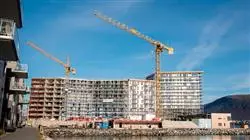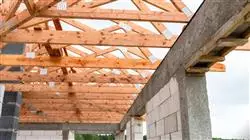University certificate
The world's largest faculty of engineering”
Introduction to the Program
Master the latest market tools to execute construction projects that contribute to sustainable development"

This Postgraduate diploma aims to boost the career of engineers who wish to delve into the management of innovation and quality in the field of building, through a set of in-depth knowledge presented on a virtual platform accessible 24 hours a day. In this way, the program covers from the knowledge of different sustainable materials to the most advanced techniques of characterization of building systems.
During the course of this program, the engineer will delve into concepts related to decarbonization, construction waste and demolition. In addition, students will learn about the legal framework for the protection of the environment and the use of degraded spaces for their restoration. A broad journey in which the student will also delve into additive manufacturing through 3D printing or automation in structures. Finally, the graduate will acquire skills related to Quality Management Systems such as ISO standards. It is, therefore, a unique opportunity to delve into a booming sector that continues to grow.
And to facilitate the student's learning, this program has a pioneering methodology such as Relearning, which allows acquiring knowledge in a progressive way by reviewing the most important concepts throughout the course. This and the 100% online format of the program make it the best option in the academic market. Therefore, graduates will only need an electronic device and an Internet connection to study from wherever and whenever they want.
Take a step further in your professional career and become the expert that companies are looking for"
This Postgraduate diploma in Integrated Management and Quality Innovation in Construction and the Environment contains the most complete and up-to-date program on the market. The most important features include:
- The development of case studies presented by experts in Integrated Management and Quality Innovation in Construction and the Environment
- The graphic, schematic and eminently practical contents with which it is conceived provide technical and practical information on those disciplines that are essential for professional practice
- Practical exercises where self-assessment can be used to improve learning
- Its special emphasis on innovative methodologies
- Theoretical lessons, questions to the expert, debate forums on controversial topics, and individual reflection assignments
- Content that is accessible from any fixed or portable device with an Internet connection
Engineering is committed to environmental protection as one of its main challenges. Acquire all the necessary tools and be part of the change"
The program’s teaching staff includes professionals from the field who contribute their work experience to this educational program, as well as renowned specialists from leading societies and prestigious universities.
Its multimedia content, developed with the latest educational technology, will provide the professionals with situated and contextual learning, i.e., a simulated environment that will provide an immersive education programmed to learn in real situations.
This program is designed around Problem-Based Learning, whereby the professional must try to solve the different professional practice situations that arise during the course. For this purpose, the students will be assisted by an innovative interactive video system created by renowned and experienced experts.
Delve into new techniques in the manufacture of construction materials and create innovative buildings"

You only need an electronic device and an Internet connection to study from wherever and whenever you want. A program adapted to you"
Why study at TECH?
TECH is the world’s largest online university. With an impressive catalog of more than 14,000 university programs available in 11 languages, it is positioned as a leader in employability, with a 99% job placement rate. In addition, it relies on an enormous faculty of more than 6,000 professors of the highest international renown.

Study at the world's largest online university and guarantee your professional success. The future starts at TECH”
The world’s best online university according to FORBES
The prestigious Forbes magazine, specialized in business and finance, has highlighted TECH as “the world's best online university” This is what they have recently stated in an article in their digital edition in which they echo the success story of this institution, “thanks to the academic offer it provides, the selection of its teaching staff, and an innovative learning method aimed at educating the professionals of the future”
A revolutionary study method, a cutting-edge faculty and a practical focus: the key to TECH's success.
The most complete study plans on the university scene
TECH offers the most complete study plans on the university scene, with syllabuses that cover fundamental concepts and, at the same time, the main scientific advances in their specific scientific areas. In addition, these programs are continuously being updated to guarantee students the academic vanguard and the most in-demand professional skills. In this way, the university's qualifications provide its graduates with a significant advantage to propel their careers to success.
TECH offers the most comprehensive and intensive study plans on the current university scene.
A world-class teaching staff
TECH's teaching staff is made up of more than 6,000 professors with the highest international recognition. Professors, researchers and top executives of multinational companies, including Isaiah Covington, performance coach of the Boston Celtics; Magda Romanska, principal investigator at Harvard MetaLAB; Ignacio Wistumba, chairman of the department of translational molecular pathology at MD Anderson Cancer Center; and D.W. Pine, creative director of TIME magazine, among others.
Internationally renowned experts, specialized in different branches of Health, Technology, Communication and Business, form part of the TECH faculty.
A unique learning method
TECH is the first university to use Relearning in all its programs. It is the best online learning methodology, accredited with international teaching quality certifications, provided by prestigious educational agencies. In addition, this disruptive educational model is complemented with the “Case Method”, thereby setting up a unique online teaching strategy. Innovative teaching resources are also implemented, including detailed videos, infographics and interactive summaries.
TECH combines Relearning and the Case Method in all its university programs to guarantee excellent theoretical and practical learning, studying whenever and wherever you want.
The world's largest online university
TECH is the world’s largest online university. We are the largest educational institution, with the best and widest online educational catalog, one hundred percent online and covering the vast majority of areas of knowledge. We offer a large selection of our own degrees and accredited online undergraduate and postgraduate degrees. In total, more than 14,000 university degrees, in eleven different languages, make us the largest educational largest in the world.
TECH has the world's most extensive catalog of academic and official programs, available in more than 11 languages.
Google Premier Partner
The American technology giant has awarded TECH the Google Google Premier Partner badge. This award, which is only available to 3% of the world's companies, highlights the efficient, flexible and tailored experience that this university provides to students. The recognition as a Google Premier Partner not only accredits the maximum rigor, performance and investment in TECH's digital infrastructures, but also places this university as one of the world's leading technology companies.
Google has positioned TECH in the top 3% of the world's most important technology companies by awarding it its Google Premier Partner badge.
The official online university of the NBA
TECH is the official online university of the NBA. Thanks to our agreement with the biggest league in basketball, we offer our students exclusive university programs, as well as a wide variety of educational resources focused on the business of the league and other areas of the sports industry. Each program is made up of a uniquely designed syllabus and features exceptional guest hosts: professionals with a distinguished sports background who will offer their expertise on the most relevant topics.
TECH has been selected by the NBA, the world's top basketball league, as its official online university.
The top-rated university by its students
Students have positioned TECH as the world's top-rated university on the main review websites, with a highest rating of 4.9 out of 5, obtained from more than 1,000 reviews. These results consolidate TECH as the benchmark university institution at an international level, reflecting the excellence and positive impact of its educational model.” reflecting the excellence and positive impact of its educational model.”
TECH is the world’s top-rated university by its students.
Leaders in employability
TECH has managed to become the leading university in employability. 99% of its students obtain jobs in the academic field they have studied, within one year of completing any of the university's programs. A similar number achieve immediate career enhancement. All this thanks to a study methodology that bases its effectiveness on the acquisition of practical skills, which are absolutely necessary for professional development.
99% of TECH graduates find a job within a year of completing their studies.
Postgraduate Diploma in Integrated Management and Quality Innovation in Building and the Environment
TECH Global University's Postgraduate Diploma in Integrated Management and Quality Innovation in Building and Environment offers you the opportunity to advance your career in the field of construction and the environment. Through our cutting-edge program, you will acquire the knowledge and skills necessary to lead quality projects in building and promote sustainable practices in harmony with this environment. We know that professional excellence requires being updated on the latest trends and methodologies. That is why our online classes give you the flexibility to study from anywhere and at any time. Take advantage of this opportunity to acquire new knowledge and improve your skills without interrupting your current commitments. During the 6-month program, you will immerse yourself in the world of quality management in building and environmental management. You will learn best practices for project planning, execution and control, as well as the implementation of quality management systems.
Specialize in building and environmental quality management with our cutting-edge program.
By enrolling in the Postgraduate Diploma in Integrated Management and Innovation of Quality in Building and Environment, you will be supported by a highly qualified and experienced teaching team. They will guide you throughout the program, providing personalized feedback and sharing their expertise to help you achieve your professional goals. Upon completion of this specialization, you will be prepared to take on leadership roles in quality management in the building and environmental sector. You will be able to implement innovations and sustainable practices in your projects, contributing to the development of a more responsible and environmentally friendly construction. In addition, TECH will grant you a recognized certificate, validating your skills and knowledge in this constantly evolving field. Don't miss the opportunity to boost your career in the construction and environmental sector, sign up today and be part of the change towards a more sustainable and quality construction!







